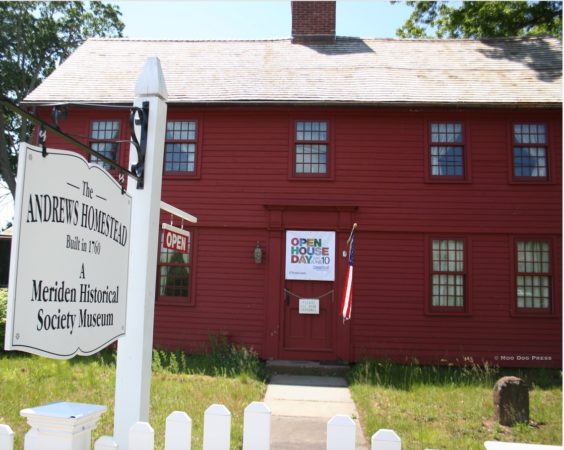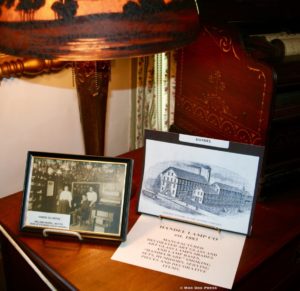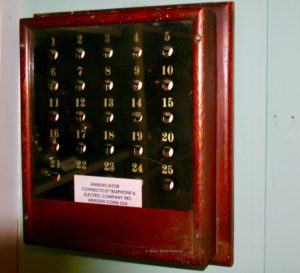Time Stop ‘Magic’: Andrews Homestead + Handel Lamp Co. + ‘Pop Goes The Weasel’
“Time is an arrow flying in only one direction: forwards.” – Henning Mankell
Time is strange. We're here now, together, sharing one planet hurtling through space in a vast universe.
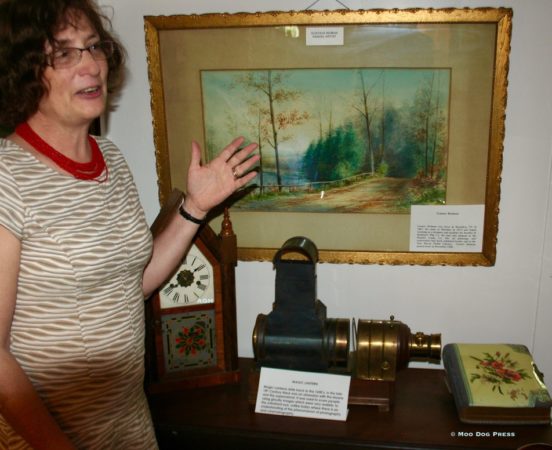
Meriden Historical Society President Ruth Borsuk. Note the painting by Gustav Reiman, an artist for Handel.
Structures – houses and other buildings – are whole artifacts shaped by human hands. Time travelers, because when they were built, those foundations places stone by stone, brick by brick – the world looked different. Inside some are collections, each object or page with a story to tell so they may be understood in context. The learning that happens on a visit varies according to the person.
“Actually a root word of technology, techne, originally meant ‘art.' The ancient Greeks never separated art from manufacture in their minds, and so never developed separate words for them.”
― Robert M. Pirsig, Zen and the Art of Motorcycle Maintenance
Within an hour's drive are a multitude of places to experience; time spent at three (1711 Solomon Goffe House; The Meriden Museum at The Andrews Homestead; General Mansfield House) made the clock stop. Listening on tours brought knowledge on early technologies, the origin of words, inventions and application – plus human history. Founders of businesses often play a key role in preservation of important architectural components for a community. Industry leaders saw what needed doing and took action. (Some did, not all have this vision.)
So why study history? This:
“Study the historian before you begin to study the facts. This is, after all, not very abstruse. It is what is already done by the intelligent undergraduate who, when recommended to read a work by that great scholar Jones of St. Jude's, goes round to a friend at St. Jude's to ask what sort of chap Jones is, and what bees he has in his bonnet. When you read a work of history, always listen out for the buzzing. If you can detect none, either you are tone deaf or your historian is a dull dog. The facts are really not at all like fish on the fishmonger's slab. They are like fish swimming about in a vast and sometimes inaccessible ocean; and what the historian catches will depend, partly on chance, but mainly on what part of the ocean he chooses to fish in and what tackle he chooses to use – these two factors being, of course, determined by the kind of fish he wants to catch. By and large, the historian will get the kind of facts he wants. History means interpretation.” – E.H. Carr.
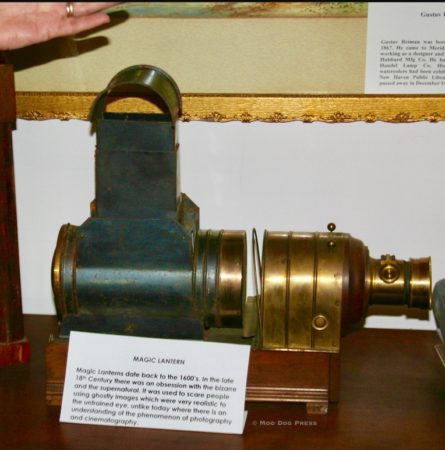
A magic lantern is an early technology to tell stories accompanied by images. Seen at the Meriden Museum at the Andrews Homestead.
On the label: “Magic lanterns date back to the 1600s. In the late 18th century there was an obsession with the bizarre and the supernatural. It was used to scare people using ghostly images which were very realistic to the untrained eye, unlike today where there is an understanding of the phenomenon of photography and cinematography.”
A reminder that whatever the technology is right now, someone, somewhere, is thinking of new ways to communicate and bridge time and space.
For instance, a magic lantern is an early technology to project ghostly images and use images to accompany stories. Magic. Projection by using optics predates photography and moving pictures. Without interpretation to help understand what is being looked at – an object remains mute, a lump of shaped form. (Take a close look at that lantern – the basic concept is similar to what became popular and mass produced in the 1960s as a Kenner Give-a-Show-projector toy.)
This is one item seen at in the collections at the Meriden Museum at the Andrews Homestead.
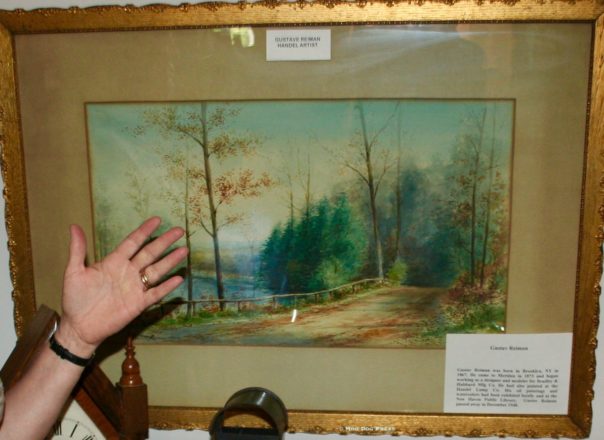
Gustave (also Gustav) Reiman was an artist for Handel in Meriden. The painting may depict the road to Castle Craig skirting Merimere Reservoir in Hubbard Park.
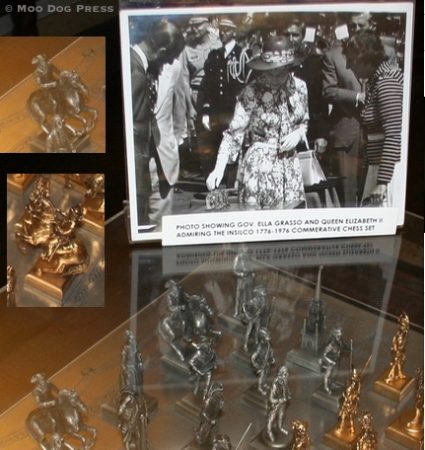
The Queen and Governor Ella Grasso meet to examine a 1776-1976 commemorative chess set in silver and gold, designed and created by Insilco.
The Meriden Historical Society members operate two buildings – the Bernice C. Morehouse Research Center in South Meriden, and the Andrews Homestead on West Main Street. For a virtual tour, visit their web site linked here, scroll down and watch a video. Highlights include Connie Mack, Rosa Ponselle, The Leatherman, Native American artifacts, maps showing locations of manufacturers, Civil War objects, cut glass artistry, more. From Wikipedia about the Handel Company: “In Meriden Illustrated (c. 1911), “[The company has] obtained [a] national reputation for the artistic and the high quality of their product. A number of patents are controlled which makes their business a very successful one. There is a force of 125 people skilled in the various branches and steadily engaged. Also at this time, the Handel Company maintained a showroom in New York City at the corner of West Broadway and Murray St. with dedicated sales agents for the entire United States. The production location was in Meriden on East Main Street, just east of Broad Street.”
Having traveled extensively and lived in various parts of the U.S., seeing beautiful objects made in Meriden are like meeting old friends. Silverware. Silverplate. Exquisite handpainted lamps. Charles Parker coffee mills and other goods.
Companies represented in the holdings here draw researchers, collectors and travelers from around the world. Many residents are unaware of the fame. There is one-page sheet, a roll call of sorts – listing company names: Aeolian Co. Bradley & Hubbard. Brenner Lamps. Charles Parker Co. Connecticut Telephone. Handel Lamp. International Silver/Meriden Britannia. Manning Bowman. Meriden Cutlery. Meriden Fire Arms. Mill Company. New Departure. Silver City Glass. Wilcox & White. (There's more. Copies of the list are available when the museum is open or by appointment; (203) 639-1913.)
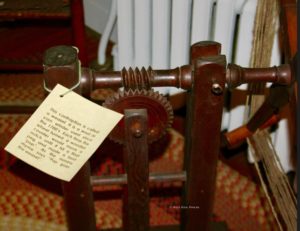
Printed on the label – “This contraption is called a weasel. It is a wool or yarn winder used since the 1700s. Each time the wheel turned, a wooden counter would move a notch until it hit a final peg and made a loud ‘pop' – as the nursery rhyme says ‘Pop goes the weasel.'”
Last, but not least – and there are hundreds of more interesting items to see – this “annunciator” with a label Connecticut Telephone & Electric Company Inc., Meriden, Conn. USA. Here is a link to the Smithsonian about the company and its products.
An annunciator is a “signaling apparatus, generally used in conjunction with a buzzer, that displays a visual indication when energized by electric current.” – Dictionary.com
Annunciator panel. United States Patent 1888584. Inventor: Cadieux, Joseph O. Application Number: US43367130A. Publication Date: 11/22/1932. Filing Date: 03/06/1930. Assignee: Connecticut Telephone & Electr(ic).
People who recall party lines and wall phones now talk via a rectangle communicator that has no wires, can roam and is tethered only by access to unseen networks (sometimes thwarted by large physical objects). Press a part of the screen and visual contact is possible, face to face, using tiny cameras and invisible technology people thought up and made real.
Magic.

